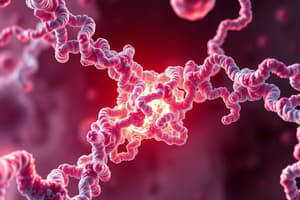Podcast
Questions and Answers
Which of the following accurately describes the quaternary structure of proteins?
Which of the following accurately describes the quaternary structure of proteins?
- It involves the arrangement of multiple polypeptide chains. (correct)
- It has no impact on the biological activity of proteins.
- It consists of one polypeptide chain.
- It is formed solely through covalent bonds.
What type of interactions link the subunits in a protein's quaternary structure?
What type of interactions link the subunits in a protein's quaternary structure?
- Non-covalent interactions (correct)
- Covalent interactions
- Peptide bonds
- Ionic interactions
In the context of quaternary structures, what is a homo-oligomer?
In the context of quaternary structures, what is a homo-oligomer?
- A protein that only has primary structure.
- A protein with different subunits.
- A protein with identical subunits. (correct)
- A protein that lacks subunits.
Which function is NOT associated with the subunits of quaternary proteins?
Which function is NOT associated with the subunits of quaternary proteins?
What happens during the denaturation of proteins?
What happens during the denaturation of proteins?
Which of the following best describes renaturation?
Which of the following best describes renaturation?
How does a change in the spatial arrangement of protein subunits affect the molecule?
How does a change in the spatial arrangement of protein subunits affect the molecule?
Hemoglobin is an example of which type of protein structure?
Hemoglobin is an example of which type of protein structure?
What process describes the return to the correct conformation of an enzyme after denaturation?
What process describes the return to the correct conformation of an enzyme after denaturation?
Which type of proteins are primarily responsible for facilitating the folding of newly synthesized polypeptide chains?
Which type of proteins are primarily responsible for facilitating the folding of newly synthesized polypeptide chains?
What role do protein disulfide isomerases (PDI) play in protein folding?
What role do protein disulfide isomerases (PDI) play in protein folding?
How much does peptidyl prolyl cis-trans isomerase (PPIase) increase the efficiency of creating native conformation?
How much does peptidyl prolyl cis-trans isomerase (PPIase) increase the efficiency of creating native conformation?
What happens to proteins that contain a cis X-Pro bond in their native structure?
What happens to proteins that contain a cis X-Pro bond in their native structure?
What is the primary consequence of inhibiting cyclophilins by cyclosporins and FK506?
What is the primary consequence of inhibiting cyclophilins by cyclosporins and FK506?
What type of linker is involved in the complex formation between PDI and proteins?
What type of linker is involved in the complex formation between PDI and proteins?
What type of enzyme is specifically involved in the cis/trans conversion of proline residues?
What type of enzyme is specifically involved in the cis/trans conversion of proline residues?
What is one characteristic of proteins associated with Alzheimer's disease?
What is one characteristic of proteins associated with Alzheimer's disease?
How does the normal prion protein structure differ from the mutant variant?
How does the normal prion protein structure differ from the mutant variant?
Which region of the brain is primarily affected in Huntington's disease?
Which region of the brain is primarily affected in Huntington's disease?
What is a common result of the genetic mutation responsible for Huntington's disease?
What is a common result of the genetic mutation responsible for Huntington's disease?
In the context of prion diseases, what type of aggregates are formed in neurons?
In the context of prion diseases, what type of aggregates are formed in neurons?
What distinguishes prion diseases from other protein conformation diseases?
What distinguishes prion diseases from other protein conformation diseases?
What happens to neurons when they are affected by mutant huntingtin proteins in Huntington's disease?
What happens to neurons when they are affected by mutant huntingtin proteins in Huntington's disease?
Which of the following correctly describes amyloid formation in Alzheimer's disease?
Which of the following correctly describes amyloid formation in Alzheimer's disease?
What is the primary consequence of the ΔF508 mutation in the CFTR gene?
What is the primary consequence of the ΔF508 mutation in the CFTR gene?
How does cystic fibrosis primarily affect the respiratory system?
How does cystic fibrosis primarily affect the respiratory system?
What role does the CFTR protein play in epithelial cells?
What role does the CFTR protein play in epithelial cells?
Which of the following pathogens is most commonly associated with cystic fibrosis airway infections?
Which of the following pathogens is most commonly associated with cystic fibrosis airway infections?
What mechanism contributes to airway destruction in cystic fibrosis patients?
What mechanism contributes to airway destruction in cystic fibrosis patients?
What is the effect of abnormal ion transport in cystic fibrosis?
What is the effect of abnormal ion transport in cystic fibrosis?
Which of the following statements is true regarding the CFTR gene mutations?
Which of the following statements is true regarding the CFTR gene mutations?
What is primarily targeted by drug therapies for cystic fibrosis?
What is primarily targeted by drug therapies for cystic fibrosis?
What role does 2,3-bisphosphoglycerate (2,3-BPG) play in hemoglobin function?
What role does 2,3-bisphosphoglycerate (2,3-BPG) play in hemoglobin function?
Which amino acid is replaced in fetal hemoglobin (HbF) that affects its affinity for oxygen compared to adult hemoglobin (HbA)?
Which amino acid is replaced in fetal hemoglobin (HbF) that affects its affinity for oxygen compared to adult hemoglobin (HbA)?
What vitamin is essential for the hydroxylation of proline and lysine during collagen maturation?
What vitamin is essential for the hydroxylation of proline and lysine during collagen maturation?
Scurvy is primarily caused by a deficiency in which nutrient?
Scurvy is primarily caused by a deficiency in which nutrient?
Which of the following statements is true regarding the action of prolylhydroxylase and lysylhydroxylase?
Which of the following statements is true regarding the action of prolylhydroxylase and lysylhydroxylase?
What is the consequence of hydroxylation of lysine and proline in collagen?
What is the consequence of hydroxylation of lysine and proline in collagen?
Which subunit of hemoglobin does 2,3-bisphosphoglycerate interact with to lower oxygen affinity?
Which subunit of hemoglobin does 2,3-bisphosphoglycerate interact with to lower oxygen affinity?
How does fetal hemoglobin's interaction with oxygen differ from that of adult hemoglobin?
How does fetal hemoglobin's interaction with oxygen differ from that of adult hemoglobin?
What is the primary role of 2,3-bisphosphoglycerate in hemoglobin function?
What is the primary role of 2,3-bisphosphoglycerate in hemoglobin function?
Which amino acid substitution in fetal hemoglobin (HbF) allows for its higher affinity for oxygen compared to adult hemoglobin (HbA)?
Which amino acid substitution in fetal hemoglobin (HbF) allows for its higher affinity for oxygen compared to adult hemoglobin (HbA)?
What is the consequence of vitamin C deficiency on collagen maturation?
What is the consequence of vitamin C deficiency on collagen maturation?
Which enzymes are responsible for the hydroxylation of proline and lysine during collagen synthesis?
Which enzymes are responsible for the hydroxylation of proline and lysine during collagen synthesis?
Which of the following best describes the role of hydroxyproline and hydroxylysine in collagen?
Which of the following best describes the role of hydroxyproline and hydroxylysine in collagen?
What is the primary clinical manifestation of scurvy due to vitamin C deficiency?
What is the primary clinical manifestation of scurvy due to vitamin C deficiency?
How does 2,3-bisphosphoglycerate affect the oxygen transport capabilities of hemoglobin?
How does 2,3-bisphosphoglycerate affect the oxygen transport capabilities of hemoglobin?
In the absence of proper hydroxylation of proline and lysine, what is the primary effect on collagen?
In the absence of proper hydroxylation of proline and lysine, what is the primary effect on collagen?
Flashcards are hidden until you start studying
Study Notes
Quaternary Structure
- Quaternary structure is the spatial arrangement of two or more polypeptide chains (subunits) forming a complex.
- Each subunit has its own primary, secondary, and tertiary structure.
- Subunits can be identical (homo-oligomers) or different (hetero-oligomers).
- Subunits are linked by non-covalent interactions (hydrogen bonds, hydrophobic and electrostatic interactions).
- Some subunits perform catalytic functions, while others are involved in recognition and regulation.
- Changes in spatial arrangement of subunits alter the molecule's properties, impacting intracellular processes.
Hemoglobin
- Hemoglobin is an example of a quaternary protein with four subunits and four hemes, each represented by a different color.
Denaturation and Renaturation
- Denaturation disrupts protein conformation due to chemical or physical agents (high temperature, acids, bases, detergents, radiation).
- Denaturation destroys quaternary, tertiary, and secondary structures, but not the primary structure.
- Denaturation can be reversible or irreversible.
- Reversible denaturation allows the molecule to regain its native conformation (renaturation) after removing the denaturing agent.
- Cells maintain protein conformation and assist in polypeptide chain folding.
Folding of Newly Synthesized Polypeptide Chains
- Special proteins facilitate the folding process, including:
- Protein disulfide isomerases: catalyze disulfide bond rearrangement to achieve the correct conformation.
- Prolyl cis-trans isomerases: catalyze the cis/trans conversion of X-Pro bonds, enhancing folding efficiency.
- Chaperones: assist in protein folding and prevent aggregation.
Protein Disulfide Isomerase (PDI)
- PDI contains an active site with two cysteine sulfhydryl groups (-SH).
- One ionized form (-S-) interacts with a disulfide bridge (S-S) in proteins, forming a disulfide-linked enzyme-substrate complex.
- The complex allows disulfide bridges to rearrange until the most stable conformation is achieved, releasing the enzyme.
Peptidyl Prolyl cis-trans Isomerases (PPIase) (Cyclophilins)
- Some proteins contain a cis X-Pro bond in their native structure.
- PPIase catalyzes cis/trans conversion of X-Pro bonds, increasing the folding efficiency.
- Inhibition of cyclophilins by cyclosporins and FK506 leads to immunosuppression, used in organ transplantation to prevent rejection.
Diseases Resulting from Disordered Protein Conformation
- Mutant proteins aggregate and form non-functional, insoluble aggregates, causing disease.
- Alzheimer's disease: amyloid aggregates form in the brain.
- Prion disease: a mutant protein converts α-helix to β-helix, leading to insolubility and resistance to proteases.
- Huntington's disease: genetic HTT mutation causes abnormal huntingtin protein folding, disrupting neuronal function and leading to neuronal death.
Sickle Cell Anemia
- Replacement of polar glutamate with hydrophobic valine in HbS changes conformation and physicochemical properties, facilitating polymerization and precipitation of HbS.
- This precipitation leads to hemolysis of erythrocytes (red blood cells), causing anemia.
Cystic Fibrosis (CF)
- CF is caused by mutations in the CF transmembrane conductance regulator (CFTR) gene, affecting chloride and sodium ion transport across epithelial cell membranes.
- Mutations lead to thick mucus buildup, respiratory failure, and other systemic obstructions and abnormalities.
- The ΔF508 mutation, the most common CF mutation, leads to abnormal CFTR protein synthesis and degradation.
- CFTR deficiency results in decreased chloride ion permeability, causing dehydrated airway mucus and impaired airway defense mechanisms.
2,3-Bisphosphoglycerate (2,3-BPG) as a Regulator of Hemoglobin
- 2,3-BPG binds to HbA in the gap between subunits, decreasing its affinity for O2.
- This facilitates oxygen delivery to tissues.
- Fetal HbF (fetal hemoglobin) has lower affinity for 2,3-BPG, allowing it to more readily bind O2 released from maternal HbA.
Involvement of Ascorbic Acid (Vitamin C) in Collagen Maturation
- Scurvy arises from vitamin C deficiency, affecting collagen maturation.
- Vitamin C is a cofactor for prolylhydroxylase and lysylhydroxylase enzymes, which hydroxylate proline and lysine, respectively.
- Hydroxylation stabilizes collagen fibers, preventing scurvy.
Studying That Suits You
Use AI to generate personalized quizzes and flashcards to suit your learning preferences.




